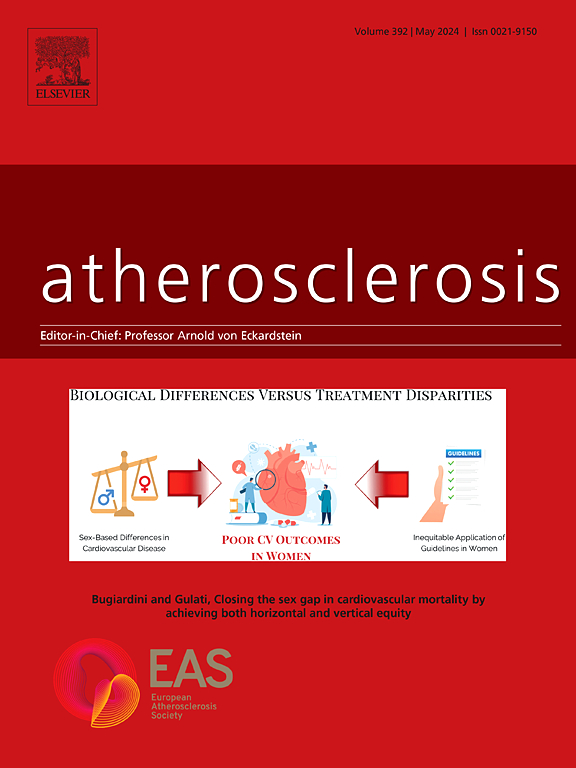中年男性主动脉血管周围脂肪组织体积的种族差异及其与动脉僵硬的关系
IF 5.7
2区 医学
Q1 CARDIAC & CARDIOVASCULAR SYSTEMS
引用次数: 0
摘要
背景与目的:以主动脉血管周围脂肪组织(aPVAT)为代表的局部脂肪储存库正成为影响心血管健康的关键因素。非洲血统的个体有较低的异位脂肪水平,包括内脏脂肪组织(VAT),比欧洲血统。然而,aPVAT体积的种族差异及其与动脉硬度的关系尚不清楚。方法本横断面研究调查了325名40-49岁的男性(252名白人,73名非裔美国人)。aPVAT和VAT使用电子束计算机断层扫描进行量化,颈-股脉波速度(cfPWV),动脉硬度的金标准测量,使用无创测试设备进行评估。按种族比较参与者特征、aPVAT和cfPWV。多变量线性回归模型评估了种族与aPVAT之间以及aPVAT与cfPWV之间的关系,调整了心血管风险和生活方式因素、体重指数(BMI)和VAT。包括相互作用项来测试种族特异性效应。结果非裔美国人aPVAT体积明显低于白人(42.7 cm3比49.1 cm3, p = 0.01)。调整增值税后,这一差异变得不显著。aPVAT与cfPWV呈正相关,独立于VAT、BMI和其他混杂因素(β = 1.52 cm/s, p = 0.04),无种族特异性相互作用(p = 0.41)。不同种族间cfPWV差异无统计学意义(p = 0.64)。结论非裔美国人的aPVAT量低于白人,主要原因是增值税的差异。aPVAT和cfPWV之间的正相关强调了aPVAT在不同种族的动脉硬化中的潜在作用。需要进行纵向研究来探索这些关联背后的因果关系和机制。本文章由计算机程序翻译,如有差异,请以英文原文为准。

Racial differences in aortic perivascular adipose tissue volume and its association with arterial stiffness in middle-aged men
Background and aims
Ectopic fat depots, such as aortic perivascular adipose tissue (aPVAT), are emerging as key factors in cardiovascular health. Individuals of African ancestry have lower ectopic fat levels, including visceral adipose tissue (VAT), than European ancestry. However, racial differences in aPVAT volume and its association with arterial stiffness remain unclear.
Methods
This cross-sectional study examined 325 men aged 40–49 (252 White, 73 African American). aPVAT and VAT were quantified using electron-beam computed tomography, and carotid-femoral pulse wave velocity (cfPWV), the gold standard measure of arterial stiffness, was assessed using a noninvasive testing device. Participant characteristics, aPVAT, and cfPWV were compared by race. Multivariable linear regression models evaluated the association between race and aPVAT and between aPVAT and cfPWV, adjusting for cardiovascular risk and lifestyle factors, body mass index (BMI), and VAT. Interaction terms were included to test race-specific effects.
Results
African Americans had significantly lower aPVAT volume than White Americans (42.7 cm3 vs. 49.1 cm3, p = 0.01). This difference became non-significant after adjusting for VAT. aPVAT was positively associated with cfPWV, independent of VAT, BMI, and other confounders (β = 1.52 cm/s, p = 0.04), with no race-specific interactions (p = 0.41). cfPWV did not differ significantly between racial groups (p = 0.64).
Conclusions
African Americans had lower aPVAT volume than White Americans, primarily explained by differences in VAT. The positive relationship between aPVAT and cfPWV underscores the potential role of aPVAT in arterial stiffness across racial groups. Longitudinal studies are needed to explore causality and mechanisms underlying these associations.
求助全文
通过发布文献求助,成功后即可免费获取论文全文。
去求助
来源期刊

Atherosclerosis
医学-外周血管病
CiteScore
9.80
自引率
3.80%
发文量
1269
审稿时长
36 days
期刊介绍:
Atherosclerosis has an open access mirror journal Atherosclerosis: X, sharing the same aims and scope, editorial team, submission system and rigorous peer review.
Atherosclerosis brings together, from all sources, papers concerned with investigation on atherosclerosis, its risk factors and clinical manifestations. Atherosclerosis covers basic and translational, clinical and population research approaches to arterial and vascular biology and disease, as well as their risk factors including: disturbances of lipid and lipoprotein metabolism, diabetes and hypertension, thrombosis, and inflammation. The Editors are interested in original or review papers dealing with the pathogenesis, environmental, genetic and epigenetic basis, diagnosis or treatment of atherosclerosis and related diseases as well as their risk factors.
 求助内容:
求助内容: 应助结果提醒方式:
应助结果提醒方式:


